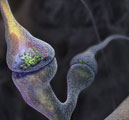DYSTONIA |
|
IntroductionDystonia describes involuntary contortion of a body part. Examples include writer’s cramp (hand dystonia), wry neck (cervical dystonia), and bent-spine syndrome (camptocormia). It is a consequence of abnormal processing by the brain of incoming sensory information resulting in the brain inappropriately repositioning a joint.
|
Recommended websitesDystonia Foundation (research)
Dystonia Parkinson Foundation (research) Care For Dystonia (info) Torticollis Foundation (info) Blepharospasm (info) More websites |





